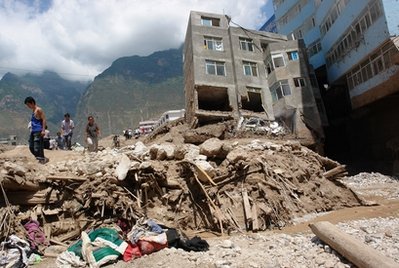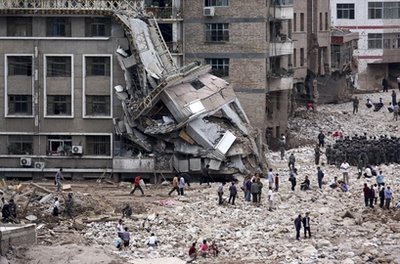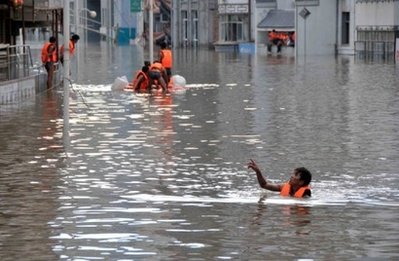
Rescuers clear up debris by hand to search In this photo released by China's Xinhua news agency, rescuers clear up debris by hand to search for missing people in landslides-hit Zhouqu county, in northwest China's Gansu Province, Aug. 9, 2010.
Rescuers lifted muddy bodies into trucks, and aid convoys choked the road into the remote Chinese town where hundreds died and more than 1,100 were missing Monday from landslides caused by heavy rain that has flooded swaths of Asia and spread misery to millions.
In Pakistan, the United Nations said the government’s estimate of 13.8 million people affected by the country’s worst-ever floods exceeded the combined total of three recent megadisasters — the 2004 Indian Ocean tsunami, the 2005 Kashmir earthquake and the 2010 Haiti earthquake.
Rescuers in mountainous Indian-controlled Kashmir raced to rescue dozens of stranded foreign trekkers and find 500 people still missing in flash floods that have killed 140.
In China, the death toll jumped to 337 late Monday after Sunday’s landslides in the northwestern province of Gansu — the deadliest incident so far in the country’s worst flooding in a decade. A debris-blocked swollen river burst, swamping entire mountain villages in the county seat of Zhouqu and ripping homes from their foundations.
“There were some, but very few, survivors. Most of them are dead, crushed into the earth,” said survivor Guo Wentao. Associated Press Television News showed the bodies of his younger brother and sister, wrapped in quilts, being carried away on a stretcher as crying relatives followed.

Buildings and roads are hit by mudslides In this photo released by China's Xinhua news agency, buildings and roads are hit by mudslides in Zhouqu county, in northwest China's Gansu province, on Suday Aug. 8, 2010. Rubble-strewn floodwaters tore through a remote corner of northwestern China on Sunday, smashing buildings, overturning cars and killing at least 127 people.
The government said 1,148 were missing Monday night. About 45,000 were evacuated. It was not known how many of the missing were in danger or simply out of contact as workers rushed to restore communications in the area, where one-third of residents are ethnic Tibetan.
More rain is expected in the region over the next three days, the China Meteorological Administration said. On Monday evening, clouds were building ominously over the mountains where the mud started flowing.
“We were dumbfounded by the enormity of the flood situation when we got to the scene,” said Chen Junfeng, a disinfection specialist whose army battalion was the first on the scene Sunday.
Photos showed wrapped bodies tied to sticks or placed on planks and left on the shattered streets for pickup. APTN footage showed workers lifting an empty coffin. In many parts of rural China, coffins are bought as insurance for old age.
“We’re saving you!” Premier Wen Jiabao shouted into the wreckage, as shown on state broadcaster China Central Television. “Is a child still down there? Take good care of the child!”
Hoping to prevent further disasters, demolitions experts set off charges to clear debris blocking the Bailong River upstream from the ravaged Zhouqu. The blockage had formed a 2-mile (3-kilometer)-long artificial lake on the river that overflowed before dawn Sunday, sending deadly torrents crashing down onto the town.
Flooding in China has killed more than 1,100 people this year and caused tens of billions of dollars in damage across 28 provinces and regions.
In Pakistan, two weeks of flooding have killed 1,500.

Rescuers and residents walk on road covered Rescuers and residents walk on a road covered by rocks and mud near a collapsed building after a mudslide triggered by heavy rains in Zhouqu county, in northwest China's Gansu province, Monday, Aug. 9, 2010. Rescuers searched Monday for an estimated 1,300 people left missing after rubble-strewn floodwaters tore through a remote corner of northwestern China, just one of a series of flood disasters across Asia that have plunged millions into misery
“It looks like the number of people affected in this crisis is higher than the Haiti earthquake, the tsunami or the Pakistan earthquake, and if the toll is as high as the one given by the government, it’s higher than the three of them combined,” Maurizio Giuliano, spokesman for the U.N. Office for the Coordination of Humanitarian Affairs, told The Associated Press.
The U.N. estimates that 13.8 million people have been affected by the Pakistan flooding — over 2 million more than the other disasters combined. The figures include people who need short-term or long-term aid.
Rescue workers have been unable to reach up to 600,000 people marooned in the northwestern Swat Valley, where many residents were still trying to recover from an intense battle between the army and the Taliban last spring, Giuliano said.
“The magnitude of the tragedy is so immense that it is hard to assess,” said Pakistani Prime Minister Yousuf Raza Gilani during a visit to the central Pakistani city of Multan.
Heavy rains continued. Rising national anger has been directed at an already unpopular government that has deployed thousands of soldiers for aid but has been overwhelmed itself.
Manzoor Ahmed, 25, was one of thousands of people who fled their homes in Sindh province in the south.
“It would have been better if we had died in the floods as our current miserable life is much more painful,” said Ahmed, who spent the night shivering in the rain.
Thousands of Pakistanis in the neighboring districts of Shikarpur and Sukkur camped out on roads, bridges and railway tracks — any dry ground they could find.
“I have no utensils. I have no food for my children. I have no money,” said Hora Mai, 40, sitting on a rain-soaked road in Sukkur along with hundreds of other people. “We were able to escape the floodwaters, but hunger may kill us.”

Rescuers seek to evacuate survivors Rescuers seek to evacuate survivors after a devastating flood-triggered landslide hit Zhouqu county, causing flooding in northwest China's Gansu province. The death toll from mudslides in northwest China surged to 337 on Monday, as rescuers used diggers and their bare hands in a desperate search for more than 1,000 others still missing.
A senior government official in Sukkur, Inamullah Dhareejo, said authorities were working to set up relief camps.
But an Associated Press reporter who traveled widely through the worst-hit areas in Sindh over the past three days saw no sign of relief camps or government assistance.
Meanwhile, the death toll from flash floods in the remote desert mountainsides in Indian-controlled Kashmir rose to 140 with the recovery of eight more bodies overnight, police said Monday. The dead included five foreigners, but their nationalities were not immediately known. An estimated 500 more people were missing.
Further east, thousands of army, police and paramilitary soldiers continued clearing roads to reach isolated villages in the Ladakh region cut off by Friday’s powerful thunderstorms.
By late afternoon on Monday, the roads leading to the worst affected village, Choglamsar, had been cleared and rescue teams looked for survivors among the flattened buildings, army spokesman Lt. Col. J.S. Brar said.
On Monday, Indian air force helicopters evacuated 80 stranded foreign tourists from Zanaskar, a popular trekking area. Those rescued included British, French, Dutch and Germans, an army statement said.
At least 33 of the missing include Indian army soldiers from a remote base who may have been washed into Pakistan-controlled Kashmir in the fast flowing Indus river, said Brig. S. Chawla, a senior official in Indian Kashmir.
He said Indian officials had informed their Pakistani counterparts to help verify those reports.
In North Korea, some 10,000 people were sheltering in public buildings in the border city of Sinuiju near China due to flooding, the Red Cross said Monday. Flash floods destroyed thousands of homes across the impoverished country, and the Amnok River had recorded its highest water level in 15 years, Red Cross said.
Did you know that if you subscribe to our website, you will receive email notifications whenever content changes or new content is added.
1. Enter your e-mail address below and click the Sign Me Up button.
2. You will receive an email asking you to confirm your intention of subscribing to our site.
3. Click the link in the email to confirm. That’s all there is to it! Note: if you wish to unsubscribe from our site, click the unsubscribe link at the bottom of the email you received.
Then indicate you no longer wish to receive our emails.
Thank You
Prisonbreakfreak.com Team